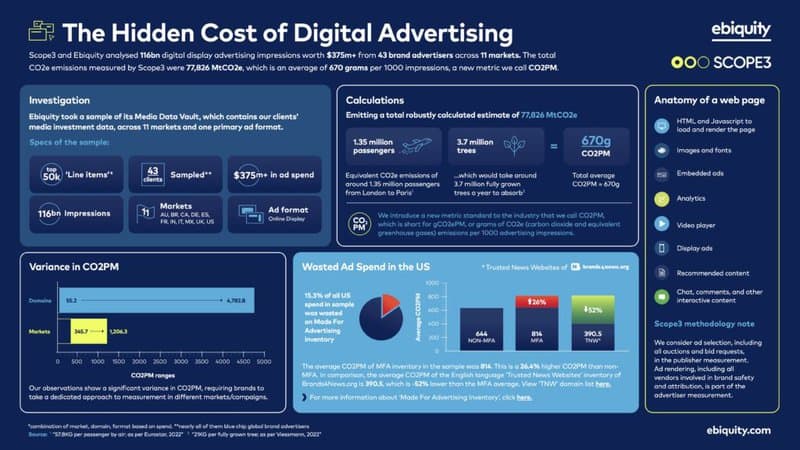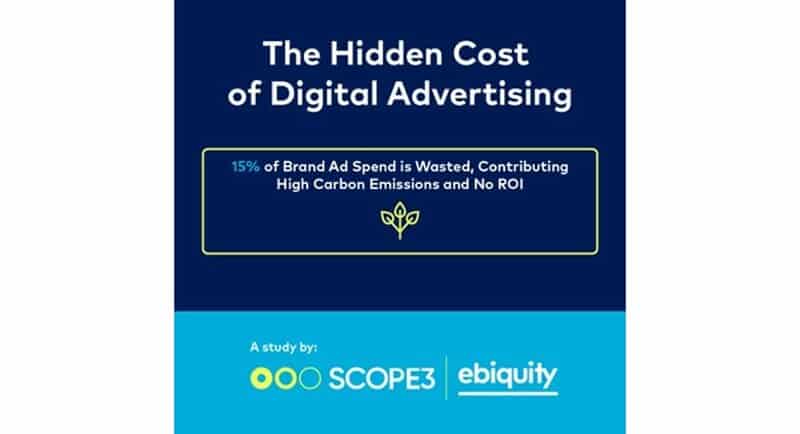Ebiquity and Scope3 have released a new report exposing the extraordinary cost of excessive supply chain waste in digital advertising and its impact on the environment.
The joint study analysed more than $375M of digital advertising spend across 116 billion display ad impressions from 43 brand advertisers and revealed that 15.3% of their advertising spend is wasted on inventory that generates no value to their business while generating excessive amounts of CO2 emissions.
The report also marks the first time that Scope3 has released global industry benchmarks using its carbon emissions measurement data, providing brands a baseline for comparison and understanding of the relative performance and cost of carbon associated with their advertising investments.
Key findings from the study include:
• Carbon emissions of websites varies dramatically with CO2PM per website ranging from 55.2g to 4,782.8g, an 87X difference. This confirms a major opportunity for brands to prioritise media partners with optimized emissions.
• The global weighted average of digital ad emissions is 670g CO2PM based on 116billion ad impressions. According to Scope3 data of 77,826 MtCO2e, this is the equivalent of flying 1.35 million passengers from London to Paris – it would take 3.7 million fully-grown trees one year to absorb this amount of carbon.
• ‘Made for Advertising’ (MFA) websites are high contributors to carbon emissions while providing no value to brands. CO2PM on MFA’ [1] websites, classified as wastage by Ebiquity, is 26.4% HIGHER than non-MFA websites. Of all US spend analysed by Ebiquity, 15.3% was wasted on MFA inventory.
• Reallocating investment to high quality journalism can boost ad effectiveness and lower emissions. CO2PM on ‘Trusted News Websites’[2] is 52% LOWER than on MFA websites, creating a strong case for brands to cease wasteful MFA spend.

Brian O’Kelley, CEO of Scope3, said: “Being able to put real numbers against the carbon emissions of digital advertising is just the beginning of a long journey to driving real change across the industry.”
“These metrics highlight that all digital advertising isn’t equal. The wide range of emissions presents a clear opportunity for the industry to make better decisions. Brands now have a guide for what to look for and how they can begin to think about reduction and optimization for more effective and carbon-neutral advertising.”
Nick Waters, group CEO at Ebiquity Plc, said: “This study demonstrates that the advertising industry is now able to quantify CO2 emissions across websites, markets and categories of media. We believe CO2PM should be adopted immediately as a core metric to influence decision-making and lead technology and media partners to optimise for sustainability.”
“The most striking insight is that brands in the sample spent 15.3% of their budget on Made For Advertising inventory which has no value.”
Waters continued: “Instead, this money could have been invested on high quality news websites, delivering high ad effectiveness in a brand safe environment, whilst supporting quality journalism, and emitting less than half of the CO2e. By acting together, we can reduce the harmful impact our industry has on the planet.”
Scope3 and Ebiquity plan to conduct additional studies and release benchmarks in 2023 for more advertising channels, including connected TV and social media platforms.
A webinar is scheduled for Tuesday, 10 January at 11am EST (4pm GMT) where Scope3 CEO O’Kelley and Ebiquity group chief product officer Ruben Schreurs will present the full findings and recommendations.
